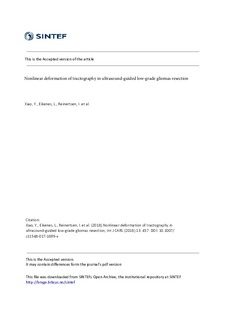| dc.contributor.author | Xiao, Yiming | |
| dc.contributor.author | Eikenes, Live | |
| dc.contributor.author | Reinertsen, Ingerid | |
| dc.contributor.author | Rivaz, Hassan | |
| dc.date.accessioned | 2019-03-25T08:10:21Z | |
| dc.date.available | 2019-03-25T08:10:21Z | |
| dc.date.created | 2018-07-02T14:31:35Z | |
| dc.date.issued | 2018 | |
| dc.identifier.citation | International Journal of Computer Assisted Radiology and Surgery. 2018, 13 (3), 457-467. | nb_NO |
| dc.identifier.issn | 1861-6410 | |
| dc.identifier.uri | http://hdl.handle.net/11250/2591482 | |
| dc.description.abstract | Purpose In brain tumor surgeries, maximum removal of cancerous tissue without compromising normal brain functions can improve the patient’s survival rate and therapeutic benefits. To achieve this, diffusion MRI and intra-operative ultrasound (iUS) can be highly instrumental. While diffusion MRI allows the visualization of white matter tracts and helps define the resection plan to best preserve the eloquent areas, iUS can effectively track the brain shift after craniotomy that often renders the pre-surgical plan invalid, ensuring the accuracy and safety of the intervention. Unfortunately, brain shift correction using iUS and automatic registration has never been shown for brain tractography so far despite its rising significance in brain tumor resection. Methods We employed a correlation-ratio-based nonlinear registration algorithm to account for brain shift through MRI–iUS registration and used the recovered deformations to warp both the brain anatomy and tractography seen in pre-surgical plans. The overall technique was demonstrated retrospectively on four patients who underwent iUS-guided low-grade brain gliomas resection. Results Through qualitative and quantitative evaluations, the preoperative MRI and iUS scans were well realigned after nonlinear registration, and the deformed brain tumor volumes and white matter tracts showed large displacements away from the pre-surgical plans. Conclusions We are the first to demonstrate the technique to track nonlinear deformation of brain tractography using real clinical MRI and iUS data, and the results confirm the need for updating white matter tracts due to tissue shift during surgery. | nb_NO |
| dc.description.abstract | Nonlinear deformation of tractography in ultrasound-guided low-grade gliomas resection | nb_NO |
| dc.language.iso | eng | nb_NO |
| dc.title | Nonlinear deformation of tractography in ultrasound-guided low-grade gliomas resection | nb_NO |
| dc.type | Journal article | nb_NO |
| dc.type | Peer reviewed | nb_NO |
| dc.description.version | acceptedVersion | nb_NO |
| dc.source.pagenumber | 457-467 | nb_NO |
| dc.source.volume | 13 | nb_NO |
| dc.source.journal | International Journal of Computer Assisted Radiology and Surgery | nb_NO |
| dc.source.issue | 3 | nb_NO |
| dc.identifier.doi | 10.1007/s11548-017-1699-x | |
| dc.identifier.cristin | 1595239 | |
| cristin.unitcode | 7401,90,25,0 | |
| cristin.unitname | Helse | |
| cristin.ispublished | true | |
| cristin.fulltext | postprint | |
| cristin.qualitycode | 1 | |
